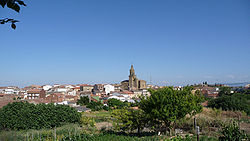This article needs additional citations for verification .(January 2020) |
San Asensio | |
|---|---|
 | |
| Coordinates: 42°30′N2°45′W / 42.500°N 2.750°W | |
| Country | |
| Autonomous community | |
| Comarca | Haro |
| Government | |
| • Mayor | Juan Francisco Blanco Zalvidea (PSOE) |
| Area | |
• Total | 32.33 km2 (12.48 sq mi) |
| Elevation | 530 m (1,740 ft) |
| Population (2024) [1] | |
• Total | 1,099 |
| • Density | 34/km2 (88/sq mi) |
| Demonym(s) | sanasensiano, na |
| Time zone | UTC+1 (CET) |
| • Summer (DST) | UTC+2 (CET) |
| Website | www |
San Asensio is a municipality and town in the La Rioja autonomous community, northern Spain.



